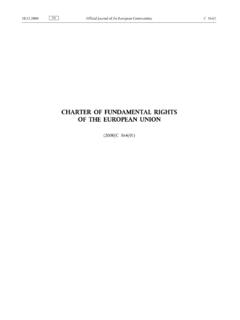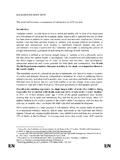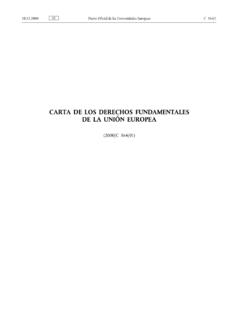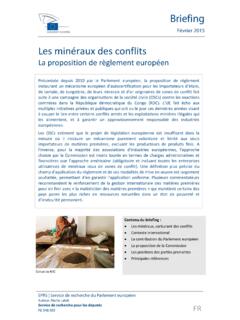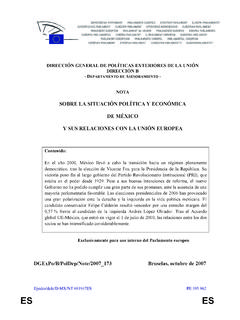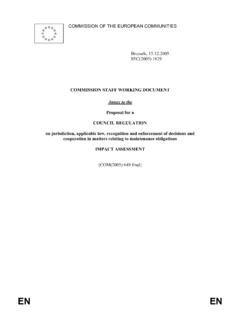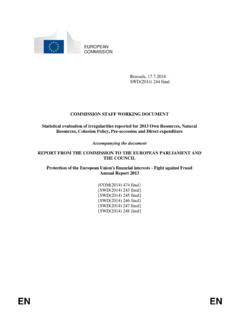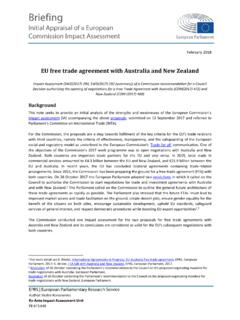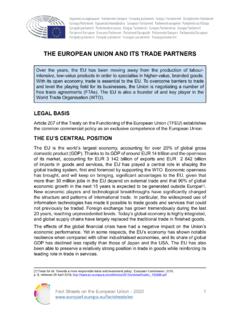Transcription of DIRECTORATE GENERAL FOR INTERNAL POLICIES
1 DIRECTORATE GENERAL FOR INTERNAL POLICIES . POLICY DEPARTMENT A: ECONOMIC AND SCIENTIFIC POLICY. Comparative study on the differences between the EU and US legislation on emissions in the automotive sector DOCUMENT DESIGNATION: STUDY. Abstract This study was commissioned by Policy Department A at the request of the committee of inquiry into emission measurements in the automotive sector (EMIS). It provides a comparative study on the differences between the EU and US legislation on emissions in the automotive sector, covering the emissions standards themselves; the systems for their implementation and enforcement, including approval systems for vehicles; and the respective regimes for prohibiting the use of defeat devices. IP/A/EMIS/2016-02 December 2016. PE EN. This document was requested by the European Parliament's Committee on emission measurements in the automotive sector. AUTHOR(S). Martin NESBIT, Institute for European Environmental Policy Malcolm FERGUSSON, independent expert Alejandro COLSA, Institute for European Environmental Policy Jana OHLENDORF, Institute for European Environmental Policy Christina HAYES, Institute for European Environmental Policy Kamila PAQUEL, Institute for European Environmental Policy Jean-Pierre SCHWEITZER, Institute for European Environmental Policy RESPONSIBLE ADMINISTRATOR.
2 Tina OHLIGER. EDITORIAL ASSISTANT. Irene VERNACOTOLA. LINGUISTIC VERSIONS. Original: EN. ABOUT THE EDITOR. Policy departments provide in-house and external expertise to support EP committees and other parliamentary bodies in shaping legislation and exercising democratic scrutiny over EU. INTERNAL POLICIES . To contact Policy Department A or to subscribe to its newsletter please write to: Policy Department A: Economic and Scientific Policy European Parliament B-1047 Brussels E-mail: Manuscript completed in November 2016. European Union, 2016. This document is available on the Internet at: DISCLAIMER. The opinions expressed in this document are the sole responsibility of the author and do not necessarily represent the official position of the European Parliament. Reproduction and translation for non-commercial purposes are authorised, provided the source is acknowledged and the publisher is given prior notice and sent a copy. Comparative study on the differences between the EU and US legislation on emissions in the automotive sector CONTENTS.
3 LIST OF ABBREVIATIONS 5. LIST OF FIGURES 7. LIST OF TABLES 7. EXECUTIVE SUMMARY 9. INTRODUCTION 12. REGULATORY emissions LIMITS IN THE EU AND THE US AND THEIR. DEVELOPMENT OVER TIME 14. Air quality emissions limits in the US and the EU 14. Air quality standards in the US 16. The development of federal standards over time 17. California Standards 19. Air quality standards in the EU 20. How did EU standards develop over time? 23. EU and US legislation on greenhouse gas emissions 24. EU legislation on greenhouse gas emissions 26. US legislation on greenhouse gas emissions 27. Technologies used in light vehicles to comply with emissions legislation 29. Diesel engine management 29. Exhaust gas recirculation (EGR) 29. Lean NOx trap (LNT) 30. Selective catalyctic reduction (SCR) 30. Diesel particulate filter (DPF) 30. Recent developments 31. The use of diesel abatement technologies in the EU and USA 31. SYSTEMS FOR TYPE APPROVAL, CONFORMITY OF PRODUCTION, AND.
4 IN-SERVICE PERFORMANCE IN THE EU AND THE US 32. Comparison of approaches to type approval and vehicle performance in the EU. and the US 32. Type approval in the EU 33. Equivalents to type approval in the US 35. Conformity of production in the EU 36. Conformity of production in the US 37. In-service performance verification in the EU 37. In-service performance verification in the US 39. Testing regimes in the EU 39. Testing regimes in the US 43. PE 3. Policy Department A: Economic and Scientific Policy IMPLEMENTATION AND ENFORCEMENT IN THE EU AND THE US 47. Comparison of EU and US approaches to implementation and enforcement 47. Implementation in the EU 47. Implementation in the US 47. Enforcement in the EU 48. Enforcement in the US 51. IMPACT OF THE EFFECTIVENESS OF IMPLEMENTATION 53. Direct impacts in the EU 53. Indirect impacts in the EU 54. Impacts in the US 55. COMPARATIVE ANALYSIS OF EU AND US LEGISLATION ON DEFEAT. DEVICES 58. Definition of defeat device 58.
5 Exceptions to the defeat device ban 59. Implementation of the defeat device ban 59. Enforcement of defeat device legislation 61. Possible uses of defeat devices in the EU 62. Defeat devices used in the US 64. The 1998 Honda and Ford Cases 66. Volkswagen Case (2009-2015) 67. Concluding comments on defeat devices 68. AN OUTLINE OF POTENTIAL IMPACTS OF THE EU LEGISLATION AND. ITS IMPLEMENTATION ON THE BEHAVIOUR OF STAKEHOLDERS 69. CONCLUSIONS AND POLICY OUTLOOK 71. BIBLIOGRAPHY 73. ANNEX 1 CASE STUDY ON TYPE APPROVAL IN GERMANY 81. ANNEX 2 US FEDERAL STANDARDS 83. ANNEX 3 - CALIFORNIA STANDARDS 90. 4 PE Comparative study on the differences between the EU and US legislation on emissions in the automotive sector LIST OF ABBREVIATIONS. AECD Auxiliary Emission Control Device CAA Clean Air Act (US). CAFE (US) Corporate Average Fuel Economy; (EU) Clean Air for Europe programme CARB California Air Resources Board CF Conformity Factor CO2 Carbon dioxide CoP Conformity of Production DPF Diesel Particulate Filter EGR Exhaust Gas Recirculation EMIS Committee on emission measurements in the automotive sector EPA (United States) Environmental Protection Agency GVWR Gross vehicle weight rating HDV Heavy-duty vehicle ICCT International Council on Clean Transportation LDT Light-duty truck LEV Low Emission Vehicle LNT Lean NOx Trap MDPV Medium-duty passenger vehicle MNHC Non-methane hydrocarbon MY Model Year NEDC New European Driving Cycle NMOG Non-methane organic gases NOx Nitrogen oxides PE 5.
6 Policy Department A: Economic and Scientific Policy NTE Not-to-exceed limit OBD On-board diagnostics OEM Original Equipment Manufacturer PEMS Portable emissions Monitoring System PM Particulate Matter RDE Real Driving emissions SCR Selective Catalyctic Reduction T&E Transport and Environment (NGO). TAA Type Approval Autority TCMV Technical Committee on Motor Vehicles UNECE United Nations Economic Commission for Europe VW Volkswagen Aktiengesellschaft WLTP/WLTC Worldwide harmonized Light Vehicles Test Procedure/ Cycle 6 PE Comparative study on the differences between the EU and US legislation on emissions in the automotive sector LIST OF FIGURES. Figure 1: Comparison of Historical and Proposed and EU Fuel Economy Standards for Light-Duty Vehicles on the CAFE Test Cycle 25. Figure 2: Aplication of diesel de-NOx technologies in new cars in 2014 31. Figure 3: A flowchart to describe the compliance life of a light-duty vehicle 36. Figure 4: New European Drive Cycle (Speed in Km/h, time in s) 40.
7 Figure 5: Differences between NEDC and the WLTP Test Cycle 40. Figure 6: Speed profile in future World Cycle WLTP compared to NEDC 41. Figure 7: The US EPA's Federal Test Procedure Driving Cycle 44. Figure 8: The US EPA's Supplemental Federal Test Procedure (SFTP) US06 45. Figure 9: The US EPA's Supplemental Federal Test Procedure (SFTP) SC03 45. Figure 10: Vehicle miles travelled compared to VOC emissions per mile. 57. Figure 11: NMOG+NO fleet average standards phase-in period 2015-2025 94. LIST OF TABLES. Table 1: Comparison of emission standards for pollutants in the US and EU 15. Table 2: Summary of main differences between US and EU vehicle regulation 16. Table 3: Developments in US Automotive emissions Standards since 1990 19. Table 4: Developments in California Automotive emissions Standards 19. Table 5: US & California emission standards for petrol passenger cars at 50,000 miles/ 5. years (100,000 miles/10 years) 20. Table 6: EU emission standards for passenger cars 21.
8 Table 7: EU Emission Standards for Light Commercial Vehicles, Compression ignition (Diesel) 22. Table 8: Projected fleet wide CO2 compliance 28. Table 9: Projected 2017-2025 fleet wide CO2 compliance levels 28. Table 10: Defeat Device Cases under Title II of the Clean Air Act 64. Table 11: Tier 1 emission standards for passenger cars and light-duty trucks, FTP 84. Table 12: Tier 1 emission standards for passenger cars and light-duty trucks, SFTP 85. Table 13: Tier 2 supplemental emission standards for passenger cars and light-duty trucks, 4000 mile SFTP 86. Table 14: Tier 3 Certification bin standards, FTP 86. Table 15: Tier 3 fleet average standards for NMOG+NOx (mg/km) 87. Table 16: Tier 3 NMOG+NO and CO standards, SFTP 87. Table 17: Phase-in schedule of Tier 3 PM standards for PM, FTP 88. Table 18: LEV Emission Standards for light-duty and medium-duty vehicles,FTP-75 91. PE 7. Policy Department A: Economic and Scientific Policy Table 19: LEV II emissions standards for passenger cars and light-duty vehicles <8,500lb, FTP-75 92.
9 Table 20: LEV II emissions standards for medium-duty vehicles, FTP-75 92. Table 21: LEV III emission standards for passenger cars, LDTs and MDVs, FTP-75 93. 8 PE Comparative study on the differences between the EU and US legislation on emissions in the automotive sector EXECUTIVE SUMMARY. This report was commissioned to assist the European Parliament's Committee of inquiry into Emission Measurements in the Automotive Sector (EMIS) by providing a clear idea of the different regulatory frameworks, stakeholders and actions taken in the EU and the US in the field of emissions from the automotive sector. The report provides in section 2 an account of the different emissions standards applying in the EU and the US, in respect of both local air quality pollutants, and greenhouse gas emissions , and explains (section ) their development over time. It then explains in detail (section 3) the different approaches in the EU and the US to implementation of standards, including the rules for ensuring that vehicles placed on the market comply with the legislation (through type approval in the EU, and a system of certificates of conformity in the US).
10 It describes the respective test regimes used to determine compliance with emissions standards, and provides a short description of the types of emissions control technologies deployed by manufacturers in the EU and the US to meet the standards. The respective systems for implementation and enforcement of emissions standards are then described in Section 4, outlining in GENERAL terms the impacts on environmental outcomes, particularly in the EU, of the enforcement of emissions standards. A key question for the EMIS Committee is the use of so-called defeat devices (mechanisms which detect the conditions under which the vehicle is operating in order to trigger changes in the operation of emissions control technologies). Given the risk that manufacturers might use such devices to ensure that emissions recorded in tests are more favourable than emissions in real-world performance of the vehicle in normal use and road conditions, defeat devices are in principle banned in both the US and EU.
